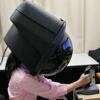visits
2390
votes
18
votes++Vote positively this post :)
+35
votes--Vote negatively this post :(
-17
Evolution of the virtual reality

-Early (years 60):
Not a lot of time after of the firsts emissions of the color television, the first machines and helmets of virtual reality started to be patented. These wasn't interactive, due to the impossibility in that epoch of generate 3D graphics by computer in real time, but include other interesting characteristics, that I comment below.

1956: This year, Morton Heilig, invented the first virtual reality machine although wasn't patented since 1962. Was called Sensorama and combined full color 3D video, audio, vibrations, wind and odors. It had only 5 movies of two minutes every one.
1960: The same Heilig patented the first head mounted display. This served to see 3D slides, hear in stereo and had a odor generator.
1961: The next year Corme and Byen built the first helmet called Headsight, that had attached one CRT screen and, using a tracking magnetic system, knew the direction of the head. This apparatus was thinked for military applications. The idea was controlling something remotely, for instance, a vehicle in a dangerous situation. The user was seeing the video that was sending the video camera of the vehicle.

1965: Ivan Sutherlan created a helmet called Ultimate Display. This had two CRT screens to show 3D images and had also of a mechanical head tracking system.
1966: Tom Furness created the first flight simulator for the army forces. From this moment the attempts to get better flight simulators will become in a boost to the development of the virtual realty, thanks to the economical support of the defense department of the United States.
1968: Sutherland with the help of Bob Sproul created the first helmet of virtual reality and augmented reality, called the Damocles sword. Was very heavy and unrealistic because the 3D graphics generated by computer only shows a 3D wire.
- Years 70:
A serie of algorithmic advances in graphical computation during this epoch made possible that the following generation of computers could show interactive 3D graphics more realistics.
1977: In the MIT is created the Aspen Movie Map, where the users could move inside the city of Aspen in Colorado, using for this photos of the city. Something seemed to the actual Street View of Google.
- Years 80:
As I said, in the years 70 was developed the algorithms to show 3D graphics by computer, but until the years 80 these graphics can't be generated in real time, because in that moment the computers don't had sufficient performance to generated it.
1980: The company StereoGraphics makes a glasses of stereo vision.
1982: Helmet of Scott Fisher to the Nasa. Served to see and hear in 3D. The audio in 3D is achieved with a binaural system, that is necesary use with headphones.
1986: Jaron Lanier, invented the term virtual reality, using it in a conversation about the work of Scott Fisher.
1987: The english company Dimension International developed a software to build 3D worlds in a PC.
1988: Scott Foster invented a device to generate 3D binaural sound following the position of the head.
1989: ATARI launched to the market the first videogame machine with 3D technology. In this same year, Autodesk present his first system of virtual realty to PC.
- Years 90:
1991: Antonio Medina, design a virtual reality system to drive the robots of Mars from the Earth, apparently in real time, despite of the substantial delay between the signals sent.
1995: Nintendo presents in Japan and EEUU a console called Virtual Boy. This console could show 3D monochrome videogames. This was a failure, and was retreated in 1996.
- Present:
The virtual reality today has a lot of applications. It can be used as interface with the operating system, to control a distant robotic arm, play, flight simulators, etc.
But now these technologies are expensive and uncomfortable to the user. The most interesting that I have found in the net are the goggles iWear VR920, because it incorporate head tracking. This goggles has some problems, for instance, cost $ 400, the head tracking are not included in the majority of games and the 3D doesn't work with some graphic cards.
The destiny of the virtual reality will follow other paths using 3D televisions and head tracking with little sensors or using a webcam and algorithms of artificial vision, similar to the ones used in the hand tracking. The hand tracking is something, that also will be used with these technologies together. Here we have some examples:
Using as sensor, the Eye Toy of the Playstation 3 and algorithms of artificial vision